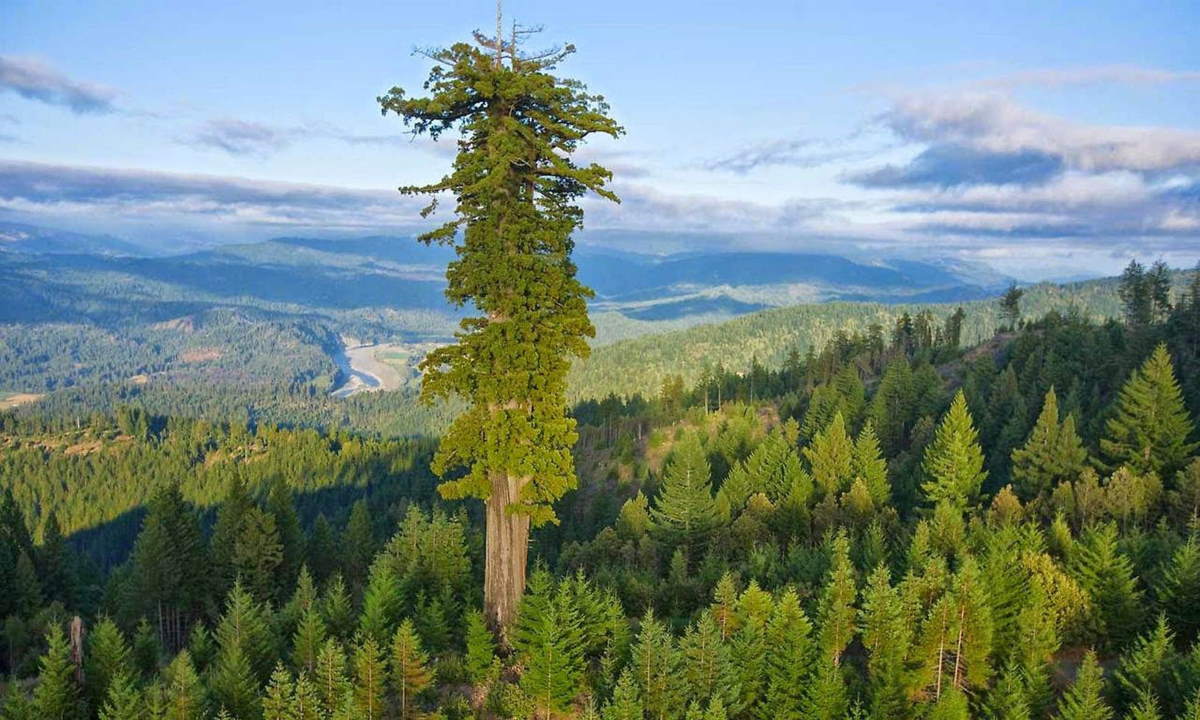Hyperion, a redwood tree soaring to an incredible 380.8 feet (116.07 meters), is the tallest tree on Earth. Nestled in the dense forests of California, this giant stands out not just for its height but for the sense of wonder and mystery it inspires. Rising above the forest canopy, Hyperion’s towering presence is a reminder of nature’s strength and resilience.
Hyperion, the world’s tallest tree
Hyperion was discovered on August 25, 2006, by naturalists Chris Atkins and Michael Taylor. Its height was confirmed at 379.1 feet (115.55 meters) by Stephen Sillett. In 2019, Hyperion was remeasured at 380.8 feet (116.07 meters).
Located in a remote part of Redwood National Park, within the original 1968 park boundaries, the area where Hyperion stands is also home to the second and third-tallest known trees: coast redwoods named Helios and Nugget, which stood at 377.13, and 373.49 feet (114.95 and 113.84 meters meters), respectively, as of 2022.
The tree is estimated to contain 530 m3 (18,600 cubic feet) of wood and to be roughly 700-800 years old. Researchers stated that woodpecker damage at the top may have prevented the tree from growing taller. According to Michael Taylor, “It’s possible it could’ve topped out at 380 feet (116 meters)”.
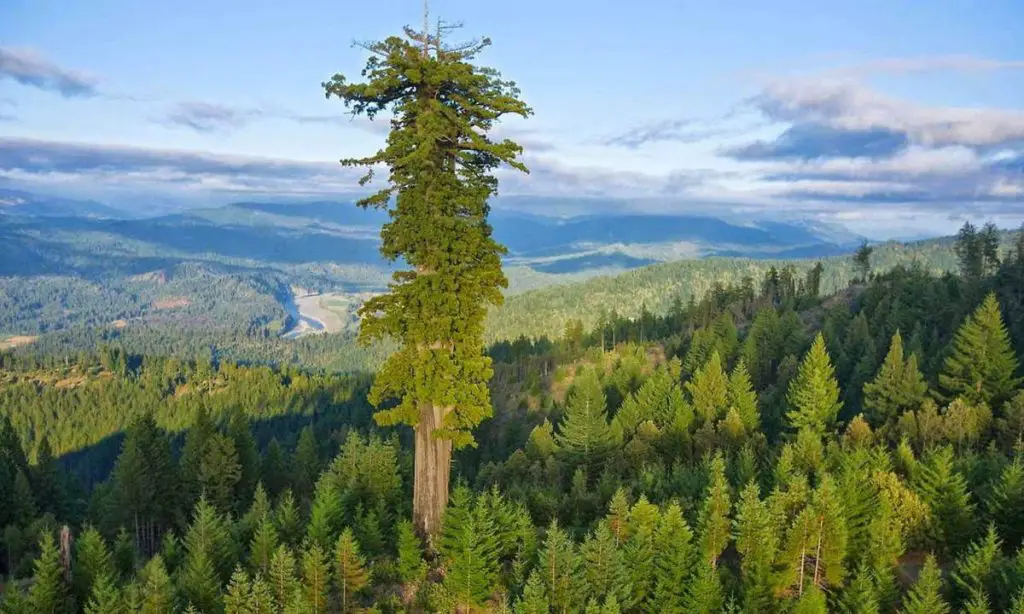
Hyperion is named after one of the twelve Titan children of Gaia (Earth) and Uranus (Sky or Heaven) in Greek mythology. With his sister, the Titaness Theia, Hyperion fathered Helios (Sun), Selene (Moon), and Eos (Dawn).
The exact location of Hyperion has not been revealed to the public for fear that human traffic would upset the ecosystem the tree inhabits (see the post titled The Impact of Overtourism on our Environment). People will want to see it, photograph it, climb it, and carve little souvenirs out of it. Steve Sillett, a botanist specializing in old-growth forest canopies says that “Trees are not like people. They ‘cannot run away from paparazzi.'”
Born on March 19, 1968, Stephen C. Sillett is a botanist specializing in old-growth forest canopies. As the first scientist to enter the redwood forest canopy, he pioneered new methods for climbing, exploring, and studying tall trees.
Sillett has climbed many of the world’s tallest trees to study the plant and animal life residing in their crowns and is generally recognized as an authority on tall trees, especially redwoods.
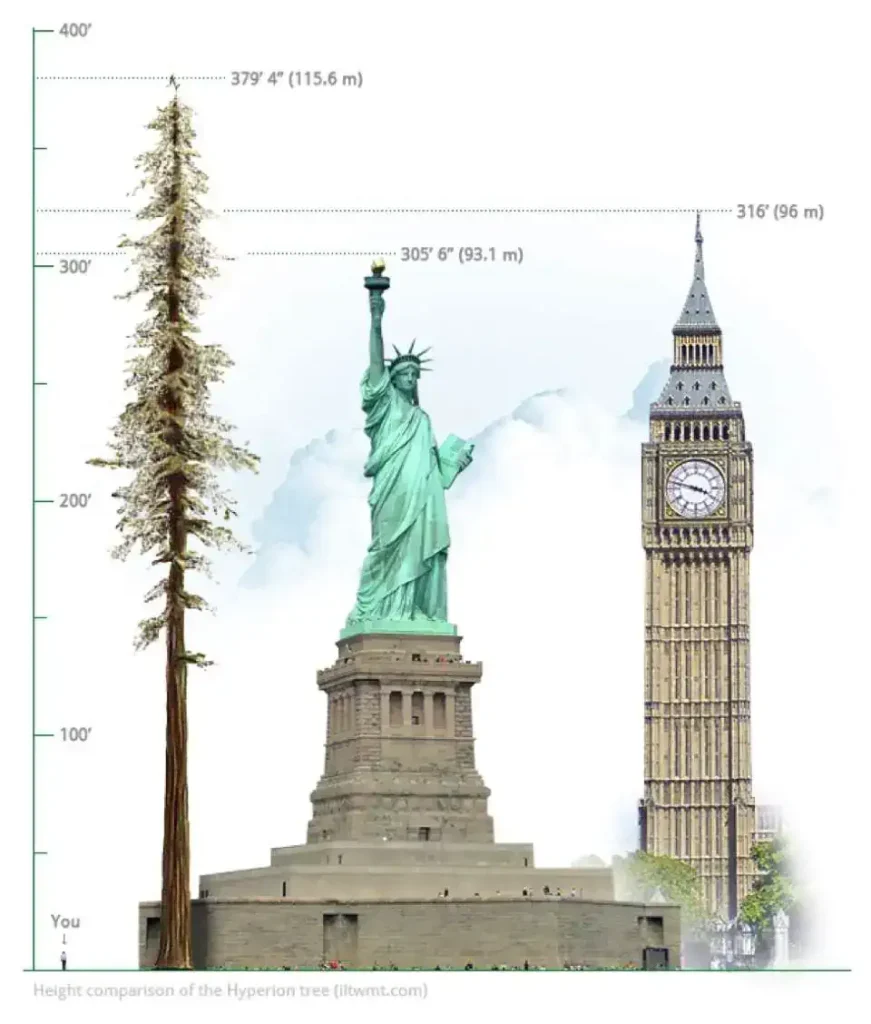
Should I Hike to Hyperion Tree? [No, You Shouldn’t]
Hyperion, the tallest tree in the world, has captivated the imagination of many tree enthusiasts since its discovery in 2006. Nestled off-trail amidst dense vegetation, reaching Hyperion is not a simple stroll but a demanding journey through rugged terrain, known as ‘bushwhacking.’ This quest, however, comes with significant environmental consequences.
The journey to Hyperion is more than just a physical challenge; it’s a moral one. As a visitor, you face a crucial decision about your impact on this fragile ecosystem. Let’s consider the implications of choosing to hike to Hyperion:
- The Impact on the Ecosystem:
- The area surrounding Hyperion has suffered from the footfall of numerous hikers. The tree resides off established trails, and the constant trampling has damaged the native vegetation and the forest’s delicate balance.
- The redwood’s roots are surprisingly shallow, averaging a depth of only 12 feet. The compression of the soil from frequent foot traffic can have detrimental effects on these ancient giants.
- Understory plants, crucial for the health of the redwood ecosystem, are vulnerable. Each step off the trail can harm these plants, disrupting the ecological harmony.
- The journey to Hyperion is not only marked by footprints but also by litter and waste, further harming the environment.
- Personal and Group Safety: The trek to Hyperion is fraught with risks. It’s an off-trail adventure in a remote area, lacking cell phone reception and reliable GPS. Even a minor injury in such an environment can escalate into a dangerous situation.
- Alternatives for Redwood Appreciation: The old-growth redwood forest is vast and offers hundreds of miles of designated trails. These trails provide safe and environmentally responsible opportunities to marvel at other magnificent redwood trees, without the risks and ecological damage associated with hiking to Hyperion.
Your choice to hike to Hyperion or not is significant. It’s a decision that weighs personal adventure against the responsibility of protecting a fragile, ancient ecosystem. By opting for established trails, you can still experience the awe-inspiring beauty of the redwoods while preserving the natural habitat for future generations.
Hiking to the Hyperion Tree is Now Forbidden
In July 2022, the Redwood Park superintendent closed off the area around Hyperion, citing damage to the surrounding habitat caused by visitors. Now, anyone who ventures too close could face up to six months in jail and a $5,000 fine.
Redwoods are the tallest trees in the world
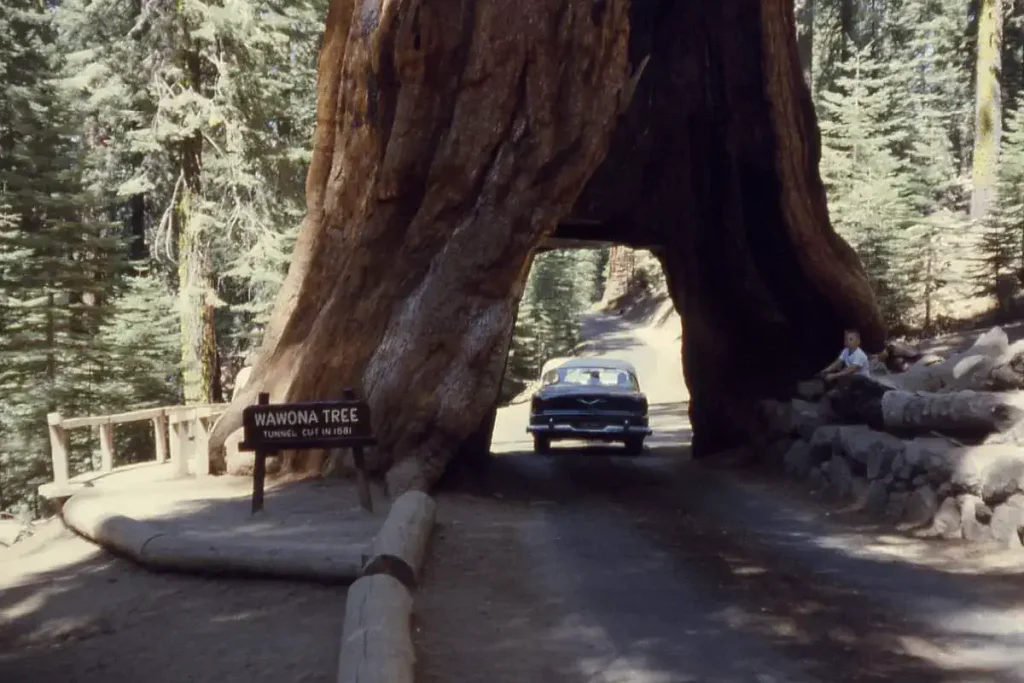
Redwoods (scientific name: Sequoia sempervirens) are the tallest trees in the world, they easily reach heights of 300 feet (91 meters) and even more. They are not the tallest only, but also evergreen and very long-lived: their
They can grow up to 29.2 feet (8.9 meters) in diameter at breast height/dbh. Redwoods live in California, United States; and before commercial logging and clearing began by the 1850s, this massive tree occurred naturally in an estimated 2,100,000 acres (8,500 km2) along much of coastal California (excluding southern California where rainfall is not sufficient) and the southwestern corner of coastal Oregon within the United States.
Now, unfortunately, an estimated 70% or more of ancient old-growth redwood trees have been displaced by environmental changes or cut down.
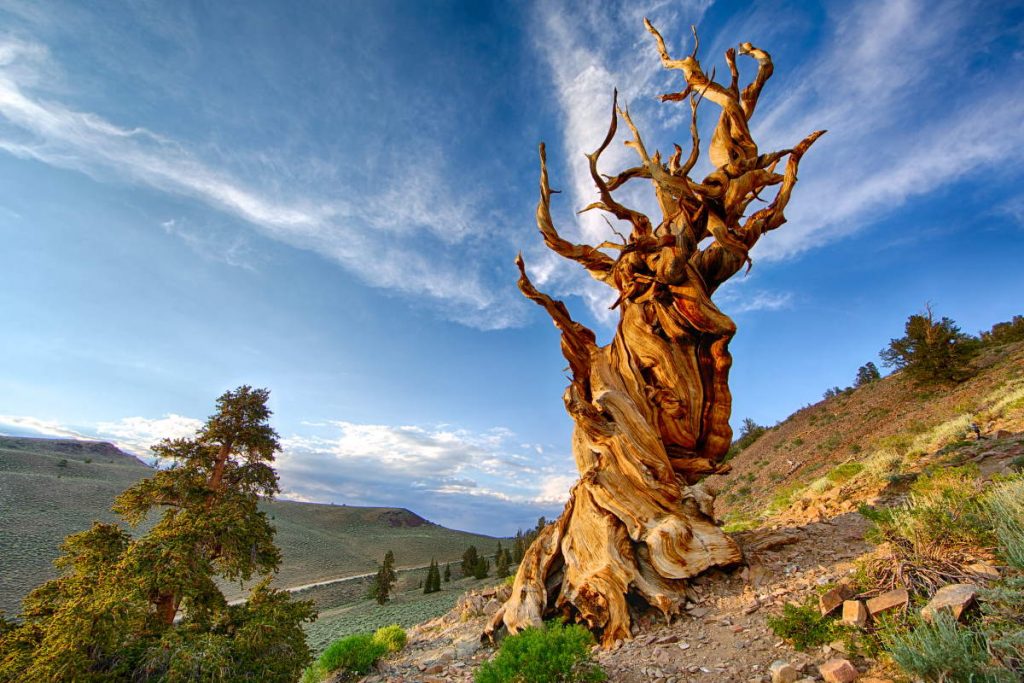
Related: Top 7 Oldest Trees in the World
Video: Climbing Hyperion Tree, the World’s Tallest
In this captivating video, forest canopy scientist Jim Spickler takes us on an extraordinary journey into the heart of Prairie Creek Redwoods State Park, where he works. The adventure began with an exhilarating call on August 25, 2006, from colleagues who believed they had discovered the world’s new tallest tree. Spickler details the meticulous expedition undertaken on September 16 to confirm this discovery.
The video showcases the challenging yet awe-inspiring process of climbing the colossal tree, involving a trek through rugged terrain, skillful shooting of ropes using a crossbow, and an arduous ascent of over 300 feet. Viewers are transported into the mesmerizing world of the tree’s crown, offering a unique perspective from the top of what could be the tallest living organism on Earth.
Spickler’s passion extends beyond the climb as he emphasizes the critical importance of protecting these ancient redwood forests, a precious and rapidly diminishing natural legacy.
Transcript of the video:
[The transcript hints at how Hyperion, officially the world’s tallest tree was discovered.]
My name is Jim Spickler. I am a forest canopy scientist, and we are currently in Prairie Creek Redwoods State Park. This is where I work.
On August 25, 2006, we got a call from an excited couple of naturals we often work with. They had good news, and their news was that they may have discovered the world’s new tallest tree.
So, on September 16, we mounted an expedition. The goal of the expedition was to climb the tree and measure its height.
The most accurate way to measure a tree’s height is to climb it and drop a tape measure from the top.
This particular tree requires a four-mile-plus walk in through really rugged terrain. The tree is located in a lost little valley on the edge of the park.
Once you get there with all your hundreds of pounds of equipment, … [Spickler shoots the rope] …it’s trying to get a rope into the tree. This involves using a high-powered compound bow or a crossbow to get a line into the tree, and then eventually getting a climbing rope into the tree.
After that, you put on your climbing gear, and it’s time to ascend 300+ feet of rope.
Just climbing up, the sense of exposure you get, is just incredible. At 200 feet, you’re still on the zone where it’s just the trunk, and then, as you get up a little bit higher, you start entering into the lower crown of the tree. And at that point, the crown envelops you. And you have the sense of… “wow, I am inside this organism, inside its arms, its branches…” And you lose for a moment the sense of the ground.
And you’re in this world – this canopy world. And as you continue up, the experience changes again. Because being that it is the tallest tree, you are climbing to a point where you are above the rest of the forest.
And, at that point, you’re on the tip of the spire. The view from the top of the world’s tallest tree is second to none.
There’s nothing like it on the ground. You cannot imagine the experience. You’re looking across one of the most spectacular remaining old-growth redwood forests, some of the tallest trees we know of (other trees) are in the same area. This is a living organism, and, it’s been there for thousands of years. And it’s ever-changing, it’s growing, and it’s becoming more complex as it gets older.
It’s an adventure. Just climbing the world’s tallest tree was one of the highlights of my life for sure.
Protecting the remaining redwood forests – it’s a very important thing to me. Of the beautiful lowland coastal forest – the most productive force – the force that was the biggest, the tallest force on the planet at one time. There’s less than 1% of those forces that remain.
These forests are so unique. If there’s just not much more of the old-growth left, and I hope that, what remains will remain with us for a long time.
Sources
- Sequoia sempervirens on Wikipedia
- Hyperion (tree) on Wikipedia
- Hyperion (mythology) on Wikipedia
- Stephen C. Sillett on Wikipedia
- Should I Hike to Hyperion? on the National Park Service website
- Famous Redwoods’ official website
- Hyperion [World’s Tallest Tree] on the Famous Redwoods website
- Helios [World’s Second Tallest Tree] on the Famous Redwoods website
- Nugget [World’s Third Tallest Tree] on the Famous Redwoods website
- How Many Elephants are Left in the World in 2025? - August 17, 2025
- Moon Landings: All-Time List [1966-2025] - February 2, 2025
- What Is Max-Q and Why Is It Important During Rocket Launches? - January 16, 2025
